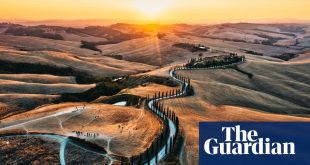Hadrian’s Wall has perhaps the most single-minded personality of all the National Trails, tracing as it does the 84 miles from Bowness-on-Solway to Wallsend, which represented the north-west frontier of the Roman empire for nearly 300 years. It was built by the Roman army (the soldiers dug the ditches, quarried the stones and laid them) on the orders of the emperor Hadrian after his visit to Britain in AD 122.
The Hadrian’s Wall path celebrates its 20th birthday this year. I’ve now walked all 17 National Trails, including the Coast to Coast path and King Charles II England coast path (officially opening in 2024 and 2025 respectively). I’m not sure why it took me so long to get round to walking the Hadrian’s Wall trail; perhaps it was a perception that it was too busy or that there was too much road walking. All my concerns proved unfounded.
I undertook the walk in the same style as my 6,800-mile walk around the coast of Britain, The Perimeter: carrying 15kg of camera and camping gear, primarily wild camping (pitching late, leaving early and staying out of sight) with a few nights in a hostel or B&B to clean and charge up.
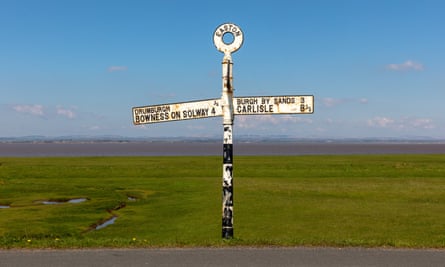

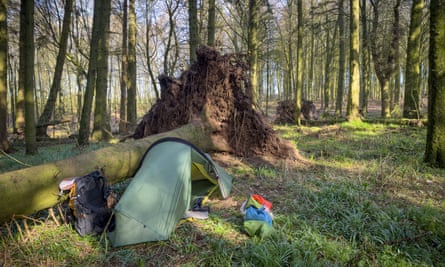
Throughout the route, there’s such a wealth of archaeological remains that it’s impossible to ignore the Roman influence, even away from the central section where the wall is most impressive and intact.
The trail starts in the expansive landscape by the Solway Firth near Anthorn Radio Station, a matrix of antennae and cables that crisscross the sky like a line drawing, used to communicate with submerged submarines and to transmit the UK’s time reference signal. It seems this landscape is destined to be marked by structures of control.
At Bowness-on-Solway, the system of ditches and wall met coastal forts that stretched along the Cumbrian coast and prevented the wall from being outflanked by sea. Although the Ordnance Survey map evocatively states “Hadrian’s Wall (Course of)” and “Vallum (Course of)”, I found it hard to make out anything on the ground. At this point, the Scottish border is only a few miles away; it’s historically an ambiguous and lawless land – home of the Reivers, the band of raiders who marauded along the frontier from the 13th to 17th centuries, conceivably set in motion by the Romans. As a result, many farmhouses here are fortified – more castle than home.
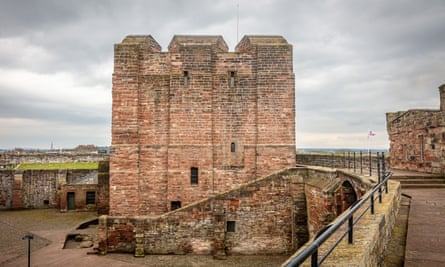
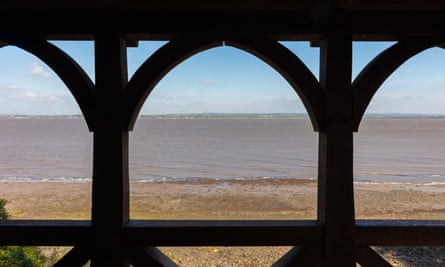
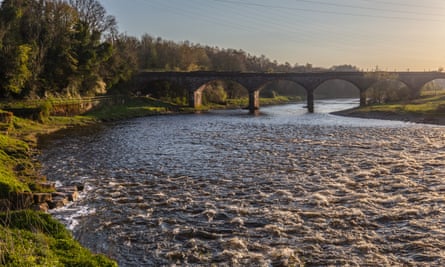
-
The path follows the River Eden to Carlisle past the imposing Norman keep. Historically, this is a lawless land. As a border stronghold between two kingdoms, the castle has been besieged 10 times – more than any other place in Britain
After leaving the expanse of sea and sky, the path follows the River Eden to Carlisle past the imposing Norman keep. The first castle was built in around 1100 on the site of a wooden Roman fort built 1,000 years earlier. As a border stronghold between two kingdoms, the castle has been besieged 10 times – more than any other place in Britain. This shows in its ruthless, architecture with a definite “Come and have a go if you think you’re hard enough” vibe where barely a stone has been placed for any purpose but to kill or defend.
As the trail starts climbing on to higher ground, 23 miles along at Old Wall, the earthworks of the wall are very clear, and there’s a panoramic view back to Blencathra and Skiddaw on the Lake District fells. I’d become so fixated on the wall, I was momentarily surprised and delighted to be reminded of somewhere else. Despite the ditch being evident, there’s still no visible wall as the stones were “borrowed” to build Lanercost Priory and other nearby buildings over the following centuries. A few hours later, with views across to the northern extent of the Pennines, I pitch my tent. Hiding behind the trunk of a wind-blown tree, I imagine myself avoiding reivers and legionaries that once roamed these lands.

Approaching Birdoswald, the foundations of the wall become thrillingly intact. A soon-to-be familiar pattern also becomes evident here: the remains of a milecastle with two turrets in between. Fourteen large forts like the one at Birdoswald were also distributed along the length of the wall, all with their granaries, hospitals, barracks, headquarters and commandants’ houses. The wall was as much a linear city as barrier.
Walking past Gilsland, where the trail leaves Cumbria and enters Northumberland, the wall is now more than a metre tall with perfectly cut facing stones as it emerges on the north-facing scarp of the Whin Sill. These are the images of the imagination, where a sinuous wall winds through a rugged moorland landscape. It feels inconceivable that these stones could have survived up here for 1,900 years. It’s hard enough to walk the route, so the gruelling nature of the construction project really becomes clear.
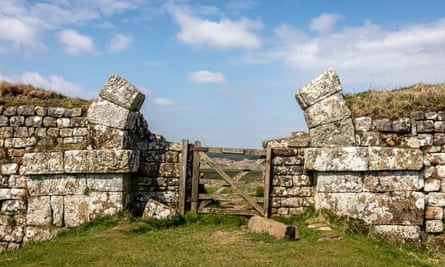
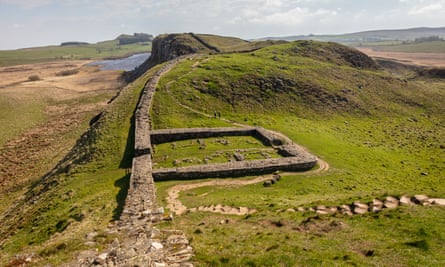
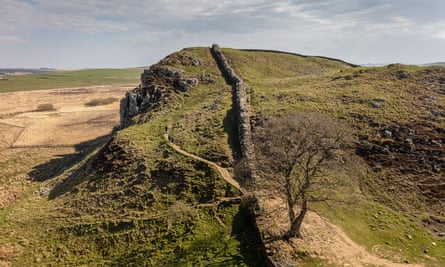
-
‘It feels inconceivable that these stones could have survived up here for 1,900 years. It’s hard enough to walk the route, so the gruelling nature of the construction project really becomes clear’
The wall was built from east to west, but I’d decided to go west to east so the prevailing wind was behind me and to enjoy the urban pleasures of Newcastle as a reward for completion. Nature laughed in my face, literally, as a cold gale-force wind blew from the east during my entire traverse.
The undulating terrain between Castle Nick and Sycamore Gap is one of the most popular and picturesque sections. Here stood the much-photographed – and recently criminally felled tree – at Sycamore Gap that featured in the 1991 blockbuster film Robin Hood: Prince of Thieves, and was crowned England’s Tree of the Year by the Woodland Trust in 2016. I patted the trunk as I walked by, not knowing that, a few months later, on 28 September 2023, the tree would be felled in an act of vandalism.
For me, the Sycamore was a reconnection with my memories as I’d walked past it 29 years previously as this section of Hadrian’s Wall Path is also on the Pennine Way, which I was following as part of a three-month walk from Land’s End to John o’Groats. I smiled on seeing the tree fuller – a measure of my own life and delighted at how familiar the place felt despite having only been here once before. For the second time, I wondered how such a mighty tree could thrive in a windswept location.
The image of the 200-year-old tree beside the nearly 2,000-year-old wall is one of those resilient memory treasures that makes long-distance walking so rewarding. Despite hearing that the tree was cut down, in my mind, it still stands as solid and improbable as it ever was. For me, the timeless poetic power of Sycamore Gap is how the tree acted as a yardstick of time: two or three times greater than human life, yet 10 times younger than Hadrian’s Wall and a mere blink of the eye compared with the 295 million-year-old geology of the Whin Sill on which both stand. I hope a sapling can grow from the felled stump, but regardless, its image, replicated by countless photographers, will endure.
Perhaps the most dramatic section is on either side of Housesteads Fort, where the wall clings closely to the jagged edge of the escarpment. Housesteads is the best preserved of the prominent forts, with a communal latrine so well engineered that it still drains when it rains today, and water tanks sealed with lead that still survive. Archaeologists found a shrine depicting three hooded spirits (Genii Cucullati) associated with fertility and prosperity. Still, they look to me more like three people waiting at a freezing and windy bus stop in Carlisle.
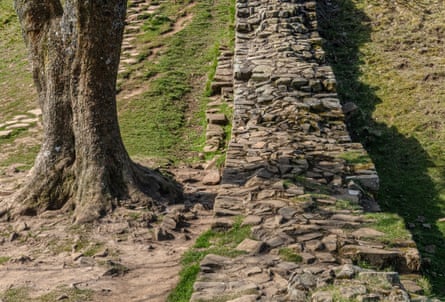
Another iconic National Trail, the Pennine Way, crosses Hadrian’s Wall on its way north to Kielder Forest, the Cheviot hills and the Scottish border. I last came this way as part of an 81-day winter walk from Land’s End to John o’Groats 24 years ago, when I slept in a bivvy bag for the entire route (and no, it wasn’t comfortable).
The Roman soldiers dug a ditch on the north side of the wall, often through solid rock. The stone was broken up with iron tools, and wooden wedges wetted to expand and split the faultlines. At “limestone corner”, the most northern part of the wall, a massive dolerite boulder, still in the ditch, bears the marks of slots cut along the lines of quartz in an unsuccessful attempt to break it up. I imagine many Roman curses were uttered over this rock. Near here, on my fourth night on the trail, I had a mildly desperate kip in the ditch itself as the gale-force wind precluded pitching the tent anywhere more exposed.

-
Hadrian’s Wall above Hotbank Crags near Housesteads Fort, perhaps the most dramatic and best preserved of the prominent forts with a communal latrine so well engineered that it still drains when it rains today. Archaeologists found a shrine depicting three hooded spirits (Genii Cucullati) associated with fertility and prosperity

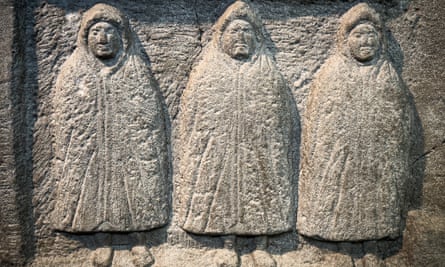
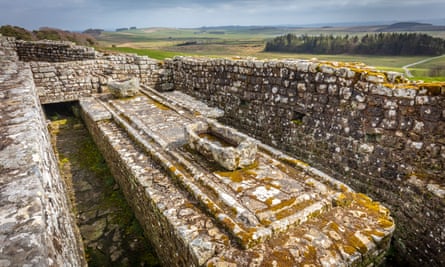
Day five starts behind schedule as there was so much to see around Housesteads yesterday, so a long 20-mile-day toward Newcastle lies ahead. A typical Roman loaded march distance. I pack the tent as a misty rain hangs in the air, the ditch disappearing into the fog ahead of me.
From Chesters Fort, the path crosses the River North Tyne from where the trail mostly runs parallel to minor roads in the adjacent fields with just the ditch and occasional traces of wall for company. After a long day of gentle downhill progress under incessant driving rain, the sky clears, and I arrive at the Tyne in darkness, finding an out-of-the-way wood to hide my tent by torchlight.
The following day on the approach to Newcastle along the Tyne, I pass the latticed timer of Dunston Staiths, one of the largest wooden structures in Europe, where coal was once taken by rail from the Durham coalfields and loaded on to ships, for transport around the world. Still soaked to the skin from yesterday’s downpour, I dry my clothes on a park bench in the sun. I have a bed to look forward to in Newcastle – and a clear view of the Tyne Bridge and the New Castle.

From Newcastle, there are just a few kilometres to Wallsend. I’m leaving the official route (which favours the picturesque Tyne riverside walk) to trace the wall’s original line through the city from Ouseburn. I’m rewarded with a fragment of the wall off Shields Road in Byker, discovered by archaeologists during excavations for the East End swimming pool in 2000 and now overlooked by a beauty salon.
A few minutes later, the wall ends at Wallsend, where Segedunum Fort provides plenty of interest for the curious, including a reconstructed section where you can appreciate the impact of its 4.5-metre height. Today the actual end of the wall is a crudely truncated section by the Swan Hunter shipyard, where its path is lost among a scattering of crisp packets. In Roman times a pier extended into the Tyne, culminating in a temple. For me, it was time to catch the Metro home and take the load off my back.
Walking the wall really reinforces the scale, seriousness, modularity and ruthless efficiency of how the Roman empire was enforced and administered. Of all the National Trails, Hadrian’s Wall follows an idea as much as a path; the thousands of hands that formed the wall remind us that while empires wax and wane, they leave persistent traces in our landscape and culture.
See more of Quintin Lake’s photos and buy prints at theperimeter.uk
 Top Naija News: Nigerian News, Breaking News Nigeria and World News Top Naija News is a daily news publication in Nigeria, delivering the latest breaking news in Nigeria and around the world.
Top Naija News: Nigerian News, Breaking News Nigeria and World News Top Naija News is a daily news publication in Nigeria, delivering the latest breaking news in Nigeria and around the world.



